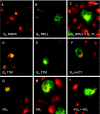Cellular localization and antigenic characterization of crimean-congo hemorrhagic fever virus glycoproteins
- PMID: 15858000
- PMCID: PMC1091677
- DOI: 10.1128/JVI.79.10.6152-6161.2005
Cellular localization and antigenic characterization of crimean-congo hemorrhagic fever virus glycoproteins
Abstract
Crimean-Congo hemorrhagic fever virus (CCHFV), a member of the genus Nairovirus of the family Bunyaviridae, causes severe disease with high rates of mortality in humans. The CCHFV M RNA segment encodes the virus glycoproteins G(N) and G(C). To understand the processing and intracellular localization of the CCHFV glycoproteins as well as their neutralization and protection determinants, we produced and characterized monoclonal antibodies (MAbs) specific for both G(N) and G(C). Using these MAbs, we found that G(N) predominantly colocalized with a Golgi marker when expressed alone or with G(C), while G(C) was transported to the Golgi apparatus only in the presence of G(N). Both proteins remained endo-beta-N-acetylglucosaminidase H sensitive, indicating that the CCHFV glycoproteins are most likely targeted to the cis Golgi apparatus. Golgi targeting information partly resides within the G(N) ectodomain, because a soluble version of G(N) lacking its transmembrane and cytoplasmic domains also localized to the Golgi apparatus. Coexpression of soluble versions of G(N) and G(C) also resulted in localization of soluble G(C) to the Golgi apparatus, indicating that the ectodomains of these proteins are sufficient for the interactions needed for Golgi targeting. Finally, the mucin-like and P35 domains, located at the N terminus of the G(N) precursor protein and removed posttranslationally by endoproteolysis, were required for Golgi targeting of G(N) when it was expressed alone but were dispensable when G(C) was coexpressed. In neutralization assays on SW-13 cells, MAbs to G(C), but not to G(N), prevented CCHFV infection. However, only a subset of G(C) MAbs protected mice in passive-immunization experiments, while some nonneutralizing G(N) MAbs efficiently protected animals from a lethal CCHFV challenge. Thus, neutralization of CCHFV likely depends not only on the properties of the antibody, but on host cell factors as well. In addition, nonneutralizing antibody-dependent mechanisms, such as antibody-dependent cell-mediated cytotoxicity, may be involved in the in vivo protection seen with the MAbs to G(C).
Figures






References
-
- Anderson, G. W., Jr., and J. F. Smith. 1987. Immunoelectron microscopy of Rift Valley fever viral morphogenesis in primary rat hepatocytes. Virology 161:91-100. - PubMed
Publication types
MeSH terms
Substances
Grants and funding
LinkOut - more resources
Full Text Sources
Other Literature Sources
Research Materials
Miscellaneous

